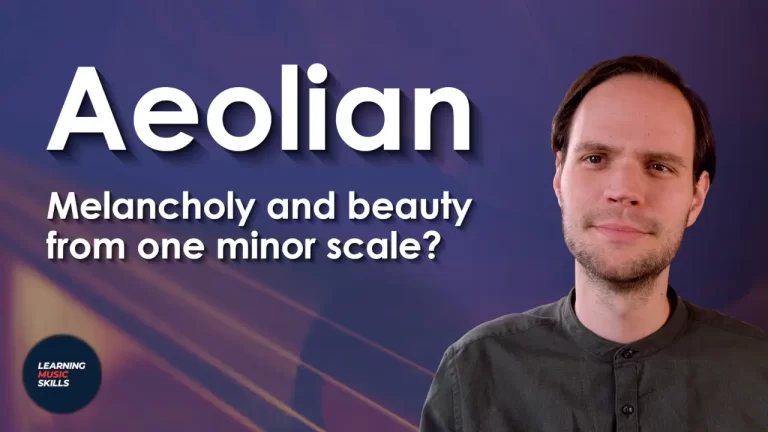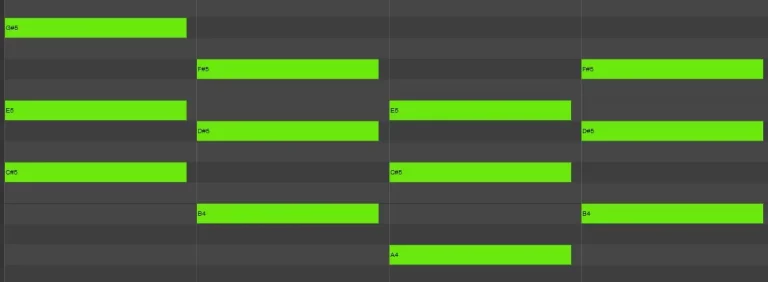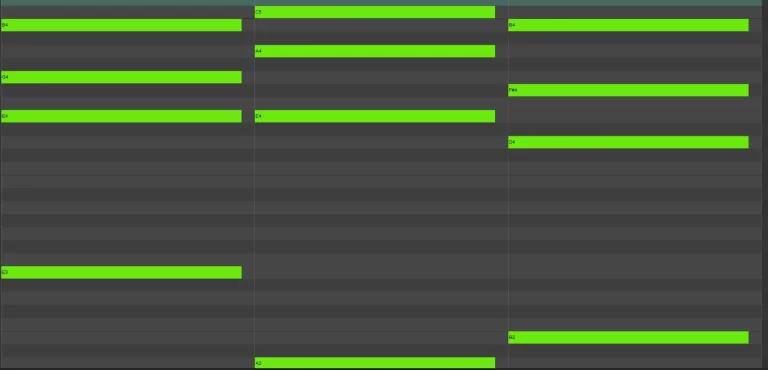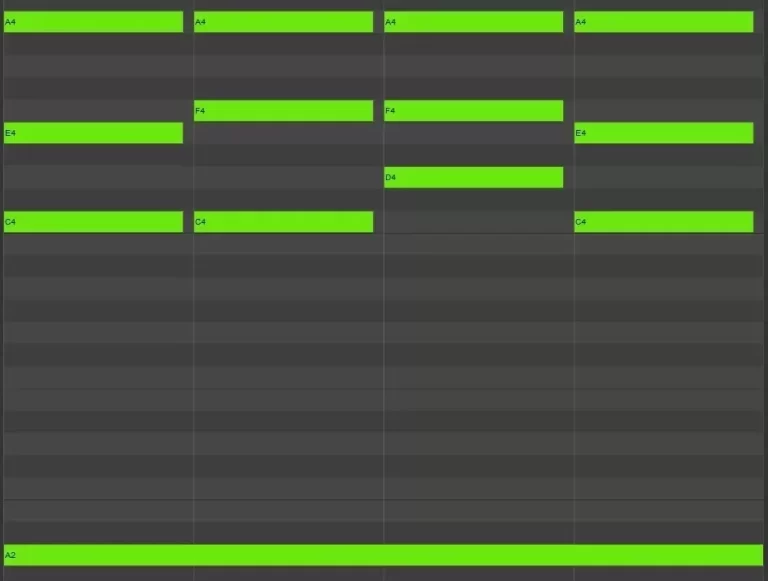The Aeolian mode or the natural minor scale as it’s called, is the backbone of many great songs and compositions. No matter the style of

Introduction
The natural minor scale or Aeolian mode can be used for dramatic and bitter-sweet melancholic
For all the guitarists out there, I think that the natural minor scale will sound very familiar to you. Since the minor pentatonic scale already has 5 of the 7 notes in it. I will explain how you make an Aeolian or natural minor scale and chord progression. And how you can use this for writing beautiful melodies and full songs. Just follow these three steps below.
How to write music in the Aeolian mode. And how to write music with minor chord progressions
- Create a natural minor scale / Aeolian scale
- Create a triad or chord on each scale degree
- Focus your chords and melody on the root note, minor third, perfect fifth and minor sixth
Video Tutorial: Make Aeolian mode / minor chord progressions and Melodies
I made a YouTube tutorial about this topic. Here you can listen to these chord progressions with real
How do you make a natural minor scale / Aeolian scale?
Most popular and tonal
Minor scale blueprint / minor scale formula
You can make a natural minor scale in any key and on any instrument that you like. Just apply this formula or blueprint of whole and half steps. Whole step – Half step – Whole step – Whole step – Half step – Whole step – Whole step
One thing where I see people making mistakes is the naming of notes. Each step needs to be a different letter from the alphabet. This means that you cannot have F and Fb or C and C#. It should be F and E or C and Db.
So what are the most important notes in a natural minor scale? The root note, the minor 3rd, minor 6th and major 2nd are the most important notes.


Is natural minor just minor?
In short, yes it is. Natural minor is just minor. But what is natural minor exactly and why use the word natural?
There are three types of minor scales: Natural minor, Harmonic minor and Melodic minor. Natural minor means that we have a pure minor scale without any notes changed. To get the harmonic minor scale you need to sharpen the 7th scale degree and for melodic minor, you need to sharpen both the 6th and 7th scale degrees.
How do you make a relative major scale?
Fun fact: If you know how to make a minor scale, then you already have all the notes that are in the major scale or Ionian scale as well. To make a major scale in any key you need to follow this fixed formula of whole and half steps: Whole Step – Whole Step – Half Step – Whole Step – Whole Step – Whole Step – Half Step.


How to make Aeolion mode / minor chord progressions
To find out what are the 7 chords in the minor scale, and start to learn how to make a minor chord progression, we will use the Aeolian scale or minor scale to find out what chords we can play in our minor chord progressions. You need to create a chord or triad on each scale degree. And you do this by only using notes from the scale!
How do you make a triad? You make a chord, by choosing one note and then you skip the next scale sten. You repeat this one more time. So for example in A minor, the chord on the first scale degree is A minor. The notes are A-C-E. We skipped the tones B and D.


Explore The Musical Modes
Create music with the musical modes in no time!
Check out my ‘Modal Playbook’ course with 43 bite-sized lessons.

Minor Chord progression No.1 in A minor
A chord progression does not always have to have many chords. Even with two chords, you can already call it a chord progression. Together examples no.1 and no.2 will use the three most important chords in any minor chord progression.
These examples are in the key of A minor. In example no.1 the Am chord has the notes A and C in it. These notes emphasize the tonic and the minor third. While the Dm chord has the F in it, which is the minor 6th.
The A and C in your Am chord emphasize the tonic and the minor third, while de Dm has the F in it, which is the minor 6th scale degree. Looking for some extra tension? You can also emphasize the major 2nd scale degree, in this case, you can do this by adding the note B to your melody. This will sound great on both chords!


Essential Minor Chord progression No.2 in A minor
This second chord progression is a very basic minor chord progression. It is a beautiful two-chord vamp of Am to Em. This is a classic i – v chord progression. The Em has a B in it, which is the major 2nd scale degree. But now the F which minor 6th scale degree is missing. As you can see it is not part of the chords, so you can add it to your melody. It can sound very nice when you play it on top of the Em chord.


Must Know Chord progression no.3 in C# minor
This progression is probably one of the most used minor chord progressions out there. It forms the harmonic backbone of countless popular songs and compositions. The smooth stepwise motion is one reason why it is a favourite. But also harmonically it has all the important notes from the Aeolian scale or natural minor scale in it. Which are the minor third, minor sixth and major second. Why don’t you try out this good minor chord progression yourself?


Explore The Musical Modes
Create music with the musical modes in no time!
Check out my ‘Modal Playbook’ course with 43 bite-sized lessons.

Chord progression No.4 in E minor With Only Minor Chords
What’s great about the Aeolian mode or natural minor is that you are able to play an i-iv-v cadence. This is the most fundamental chord progression. All the important notes of the natural minor are present. But one thing that might seem strange is that all the chords are minor in this progression. Often the chord on the 5th scale degree is a major chord. And that dominant chord as it’s called, pulls you back to your tonic. For this reason, this basic chord progression sounds less directional and has less of a pull towards your root chord.
In my video tutorial, this is a minor chord progression for piano. But of course, this might as well be a minor progression for guitar. It does not matter. The beauty is that it can sound like a laid-back minor progression or like a more emotional minor chord progression.


Chord progression No.5 in C# minor
If you want your chord progression to sound a bit brighter and softer, then you can add some major chords. In this progression, the contrast between the major chords and the minor tonic chord is wonderful. The chord on the 6th scale degree, which is the A major really sets the mood, while the E major on the 3rd scale degree creates a smooth connection with the C# minor tonic chord.
As you know by now, your melody can help accentuate important notes of your mode or scale. In this example, I did just that. Listen to the beautiful sound of the D# (which is the major 2nd) in the melody.
I turned this example into a full song. Have a listen below and download it if you want to support my work on free
Summertime by Facing Mountains


Chord progression No.6 on a pedal note in A minor
An example with a pedal note cannot be missed. Pedal notes are the best and easiest way to explore all the different colours and sounds of a certain scale or mode. There are countless examples of pedal notes used in any style of
A pedal note is when you hold a bass note and while you switch chords or play melodies your bass note stays the same. In this chord progression example, the tension and dissonance is gradually increased towards the end. This gives a final great resolution when you reach the tonic chord again.


Conclusion
Minor chord progressions have so much to offer. You can make them as dark and melancholic as you like. But even, if done correctly, you can make a minor chord progression sound happy. When you check out my video tutorial I am sure you will see and hear what I mean. If you have played the chord progressions above on your instrument then you already know!
Summary
This article might be a bit long. So that’s why I made a quick checklist of things to keep in mind for writing minor chord progressions.
- Find and use the most important notes of the scale or mode
- Find out which chords have these notes in them
- Use these chords and the tonic to confirm the mode/key strongly
- Use the melody to accentuate important notes. Like in minor: Root, Major 2nd, Minor 3rd, Minor 6th
Many composers and musicians like to use the aeolian mode or natural minor chord progressions when writing
Other videos and articles on the musical modes
Since you made it this far, I believe you might be interested in learning more. Check out my other videos and articles on the Phrygian, Lydian, Mixolydian and Dorian modes. I guarantee that there will be something interesting for you.
Once you mastered the basics of all the musical modes, you can start discovering how to mix them. This is called modal mixture, modal interchange or borrowed chords. It sounds more difficult than it really is. So if you’re looking for some more inspiration or new composing tools check out this technique. So far I have made two videos and articles about this topic. Check out my lessons on combining Lydian & Ionian and Phrygian & Aeolian.
Questions About Minor Progressions
Your Support Matters
Support new videos by becoming a member and receive benefits in return. Or by giving a one-time donation! Help me provide free
https://www.buymeacoffee.com/musicskills

